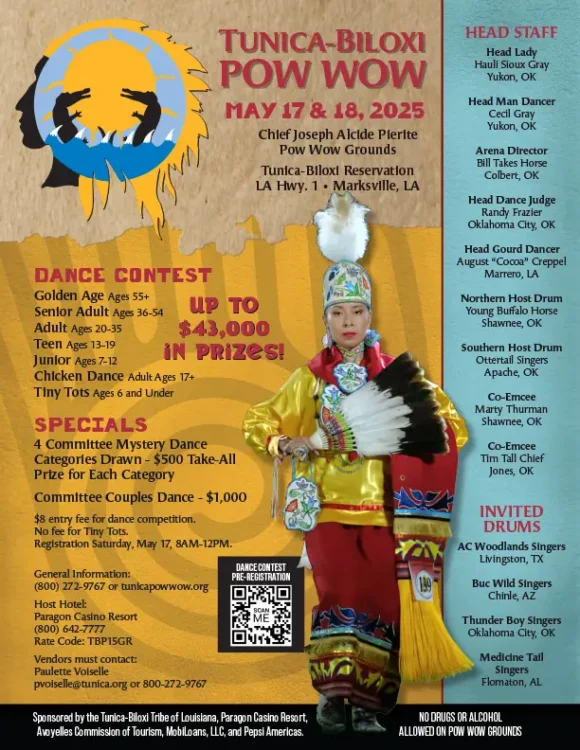We are learning the Tunica language
The Tunica-Biloxi Tribe is a successor to the historic Tunica, Biloxi, Ofo and Avoyel tribes who allied in the l8th century and became amalgamated into one in the 19th century through common interests and outside pressures from non-Indian cultures. Into the 20th century, marriage with non-Indians had begun, perhaps because of the dwindling population. The modern Tunica-Biloxi Tribe is composed of Tunica, Biloxi (a Siouan speaking people from the Gulf coast), Ofo (also a Siouan people), Avoyel (a Natchezan people), and Choctaw. Although the ancestry is often mixed, tribal members identify either as Tunica, Biloxi, or Biloxi-Choctaw. Focus on reclaiming the Tunica language is supported by a wealth of linguistic and other source materials. Less material is available on Biloxi language.
For generations, tribal families have passed down the Tunica language and traditions even though the last known fluent speaker passed away 60 years ago. There are currently 60 Tunica speakers with proficiency ranging from beginner to intermediate level. Two of the intermediate speakers learned Tunica as a second language with reinforcement of oral traditions passed down through their family. While they have a higher level of proficiency, they rely heavily on documented linguistic resources for continued learning.
In 2010, the tribe partnered with the Tulane University Linguistics Program, Department of Anthropology, to start the Tunica Language Project. In an effort to re-awaken the Tunica language, plans were put in place to work with the tribal community to bring the language back. Dr. Judith Maxwell of Tulane assembled a team of graduate students in anthropology and linguistics, with periodic support from a visiting assistant professor and Tunica-Biloxi tribal members. Tunica language instructors, Donna Pierite and Elisabeth Mora, participate actively in the project work group contributing knowledge of their family’s oral tradition in language and cultural heritage.
Tulane researchers obtained written materials on Tunica from extensive work done by John R. Swanton, Albert S. Gatschet and Mary Haas between 1886 and 1953. With these and other basic materials, the Tulane team has reconstructed the phonological and syntactic structure of the language and is in the process of preparing introductory language materials. Much more work is needed to update the Haas’ Tunica grammar, Haas’ Tunica Dictionary, and other source materials. Planning and preparation is ongoing on curricula content for training. This work has laid a foundation for classes, workshops and summer language camps since 2012. The fourth language camp held in June 2015 hosted 43 tribal children.
In an initial project, Tulane transliterated and reconfigured texts from Haas’ published narratives related by Sesostrie Youchigant, the last known fluent speaker of Tunica. The first volume of stories adapted for children was illustrated by a tribal artist and published in May 2011. The book was presented at the tribe’s general council meeting on the weekend of their annual pow wow. Three tribal youth were recorded narrating the stories and the recordings were presented as gifts to tribal elders. Another volume is near completion and is waiting funds for printing.
As the Tunica language has been dormant for decades, the Language & Culture Revitalization Program (LCRP) was created by the Tunica-Biloxi Council in 2014 to establish a structural support for language and culture education, as well as a noticeable presence of the language on the reservation and throughout the extended community. LCRP supports preservation efforts through the development and facilitation of educational programing in traditional language, history, folklore, song, dance, and crafts. LCRP is working to revitalize the Tunica language by teaching basic, culturally relevant, useful words and conversational phrases that can be applied to the daily lives of tribal members in the classroom setting, in the home, in the tribal community and in the local community.
To teach Tunica, the LCRP has adopted a modified immersion model pioneered by Dr. Maxwell which combines Total Physical Response, Immersion, and the Oxlajuj Aj methods. The Oxlajuj Aj method employs multiple instructors to enhance the learning experience and keep things moving rapidly with explicit use of regular games to summarize units. With the Tunica Language Teaching Model the LCRP department is expanding its in-person language program to include classes that range from beginners to advanced.
LCRP launched an introductory language workshop and established its first 8-week series of weekly Tunica language classes in August 2014 with 32 students enrolled. Weekly 8-week class series culminate in an Open House to engage family members. LCRP continues to promote and recruit more students from the tribal community. In an effort to reach more tribal members, LCRP developed a relationship with Northwestern State University (Louisiana) to use their distance learning system for providing online language training through WebEx. LCRP has used WebEx to produce a series of live sessions and recorded lessons for tribal members to view at their leisure. A library of recorded language lessons continues to grow and provide a resource for learning. With each language class and cultural workshop our children are remembering what they have learned. Regular feedback from families indicates that the children are speaking and singing Tunica in the home.
Dr. Wesley Leonard (Southern Oregon University) describes language reclamation as a way to achieve a level of “cultural fluency” based on what is relevant to the community. The Tunica Language Project has made traditional songs and stories accessible to tribal children and has reminded tribal adults of the importance of preserving their cultural identity. Continued use of the Tunica language is a natural way to preserve cultural knowledge and a way of expressing it through the language. Despite economic fluctuations and the perpetual effects of generational trauma, the Tunica-Biloxi still practice cultural traditions and yearn to pass them down to their children.
John Barbry
Director of Development & Programing
Language & Culture Revitalization Program
Tunica-Biloxi Tribe of Louisiana
